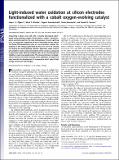Light-induced water oxidation at silicon electrodes functionalized with a cobalt oxygen-evolving catalyst
Author(s)
Pijpers, Joep J. H.; Winkler, Mark Thomas; Surendranath, Yogesh; Nocera, Daniel G.; Buonassisi, Anthony
DownloadNocera-2011-June-Light-induced water oxidation.pdf (442.9Kb)
PUBLISHER_POLICY
Publisher Policy
Article is made available in accordance with the publisher's policy and may be subject to US copyright law. Please refer to the publisher's site for terms of use.
Terms of use
Metadata
Show full item recordAbstract
Integrating a silicon solar cell with a recently developed cobalt-based water-splitting catalyst (Co-Pi) yields a robust, monolithic, photo-assisted anode for the solar fuels process of water splitting to O2 at neutral pH. Deposition of the Co-Pi catalyst on the Indium Tin Oxide (ITO)-passivated p-side of a np-Si junction enables the majority of the voltage generated by the solar cell to be utilized for driving the water-splitting reaction. Operation under neutral pH conditions fosters enhanced stability of the anode as compared to operation under alkaline conditions (pH 14) for which long-term stability is much more problematic. This demonstration of a simple, robust construct for photo-assisted water splitting is an important step towards the development of inexpensive direct solar-to-fuel energy conversion technologies.
Date issued
2011-06Department
Massachusetts Institute of Technology. Department of Chemistry; Massachusetts Institute of Technology. Department of Mechanical Engineering; Massachusetts Institute of Technology. Laboratory for Manufacturing and ProductivityJournal
Proceedings of the National Academy of Sciences of the United States of America
Publisher
National Academy of Sciences (U.S.)
Citation
Pijpers, J. J. H. et al. “Light-induced Water Oxidation at Silicon Electrodes Functionalized with a Cobalt Oxygen-evolving Catalyst.” Proceedings of the National Academy of Sciences 108.25 (2011): 10056–10061. Web.
Version: Final published version
ISSN
0027-8424
1091-6490